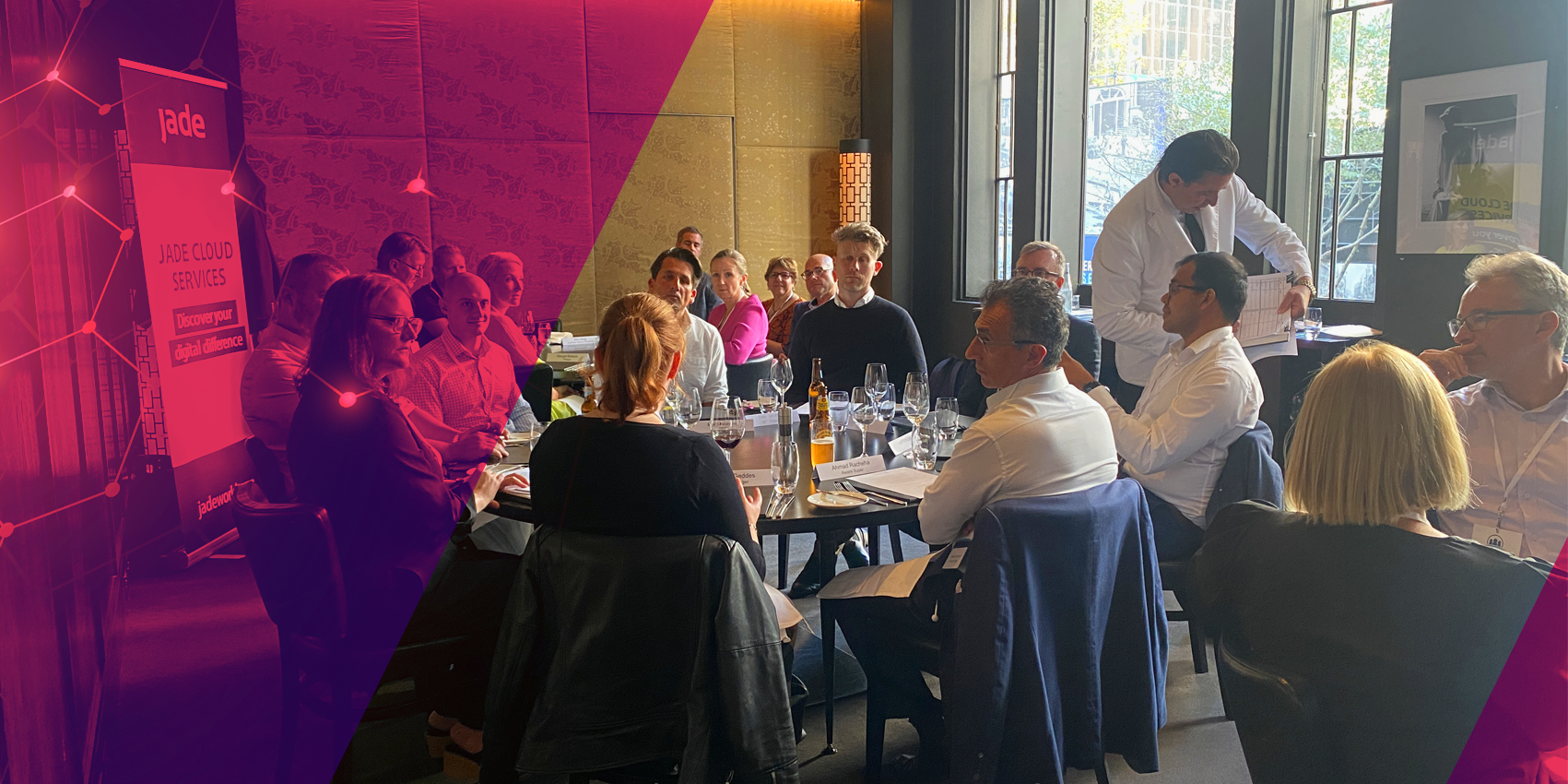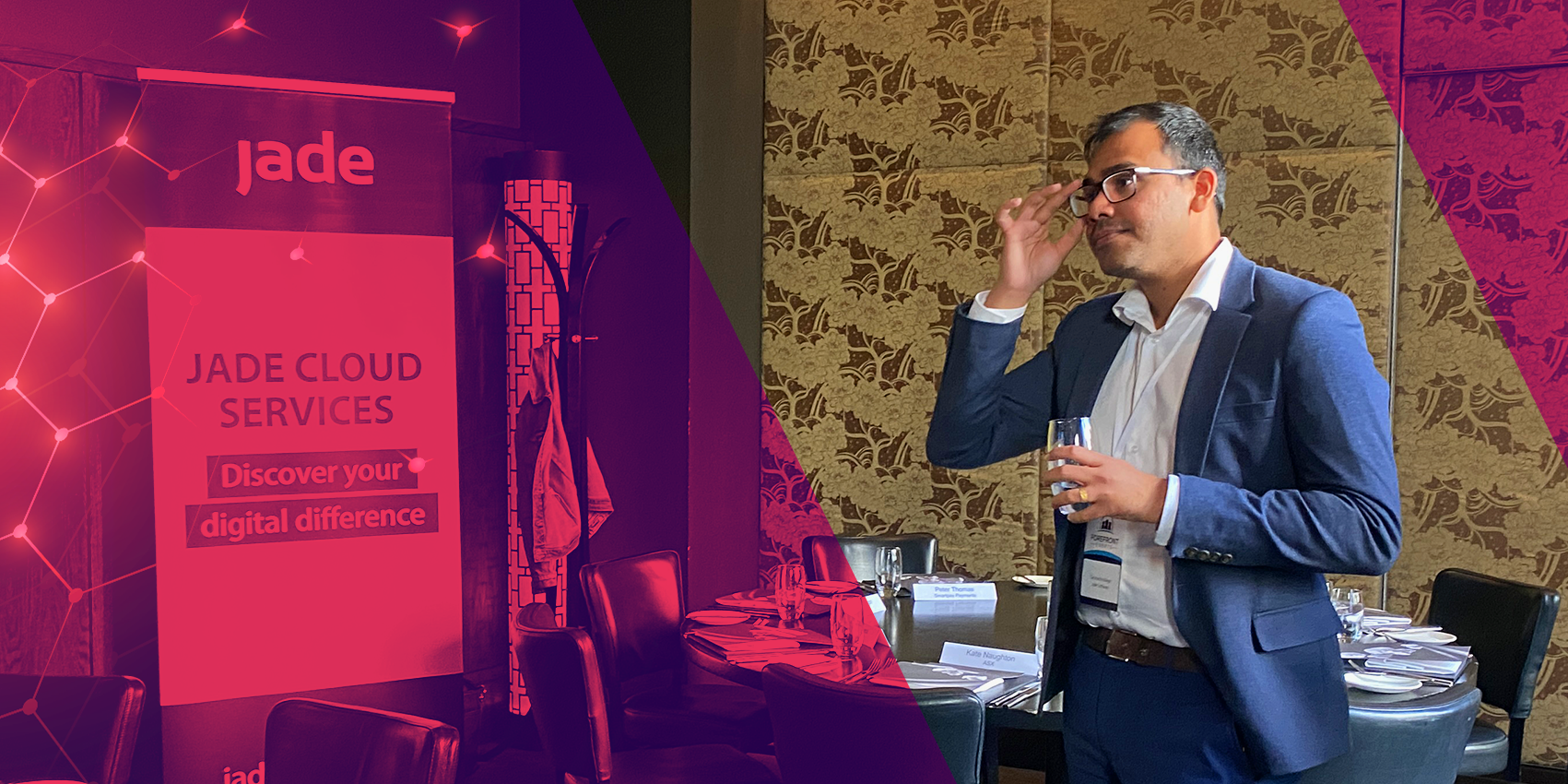Insights from a leading group of CDOs, CIOs, and heads of departments from financial institutions, whom gathered to discuss ‘The hidden challenges and opportunities that can improve your customer experience,’ at a roundtable hosted by Jade in Sydney.
Thought leaders share 10 ‘lessons learned’ on the CX journey:
- Customer journey maps, anchored in blueprints and that connect the dots, give you a CX strategy and ability to optimise over the long-term.
- You can’t iterate your way to innovation. You can only understand and deliver value based on customer need. If you only focus on optimisation, then you never deliver what’s really valuable to people. You’re just meeting needs, but missing the opportunity to delight.
- Ensure you have a realistic pulse of data to measure - and data points on customer behaviour - in order to do proper data analysis and capture valuable insights.
- To ask customers the right questions, frame the question in a way that solves the need of the problem in its entirety - rather than a piecemeal approach.
- In identifying where to start the CX journey, consider planning for a 3-5 year strategy - instead of a 6-month short-term (quick fix) project.
- UX design - understand the power of process and journey mapping - and how to successfully look inside and outside the organisation before a project kicks off.
- Understand that banking and finance is moving towards ‘instant gratification’ in CX so prepare for the complexity.
- Understand who owns the customer - and then create the customer journey map.
- Scaling operations require a ‘data rethink’ - to ensure the right balance between maintaining a ‘human-centric’ customer experience and optimisation.
- If you're consistent in your question, regardless of how pointless that question may be, you’ll be able to uncover trends.
Customer experience (CX) is the lifeblood of any business. In fact, it’s set to be the number one brand differentiator in 2021.
What’s more, research shows CX is a top priority for businesses over the next five years - and companies that focus on CX reduce churn and increase revenues - leading to higher profits. Better still, a survey conducted by Adapt, a local research and advisory firm, reveals CX as being a top priority for CIOs across Australia in 2021.
But what’s CX - and how do you even know where to start? That’s one of the questions a group of senior executives - an elite group of CDOs, CIOs, and heads of departments from financial institutions - gathered to discuss at a recent Sydney roundtable, ‘The hidden challenges and opportunities that can improve your customer experience,’ hosted by Jade.

With many financial institutions prioritising their digital transformation investments - and ramping up digital acceleration across all facets of the business - there’s a growing interest in maximising the customer and member experience in order to get a complete view of the customer and their every interaction.
In fact, getting to ‘know your customer’ - and connecting them to the right products and services in their preferred interaction channels - is not only a competitive advantage and long-term strategic differentiator, but vital in today’s increasingly connected and highly digitised world to attract, retain and delight customers across all touchpoints.
Certainly, businesses want to set themselves apart and move beyond providing basic CX experiences and instead offer more intuitive, self-service, digital experiences that will be positioned at the heart of every customer or member interaction. With digital technology transforming customer expectations, many customers, in particular, expect instant access through their mobile devices.
Therefore, with CX top of mind and high on the c-suite agenda, the select group of thought-leaders shared their experiences, pain points and challenges - along with opportunities - and what they face in the ever-changing, fast-paced and highly regulated financial services sector.
Any common challenges? Ongoing issues with legacy systems; data woes and the management conundrum; the uncertainty surrounding NPS measurements; the difficulty in prioritising CX investments; determining customer ownership; and even knowing the right questions to ask - were some of the obstacles in the multifaceted journey to adopt a CX strategy that promises seamless and personalised interactions and omni-channel engagement.
Key themes of the discussion centred around: creating value (how to build features, products and solutions that create value for the business and its customers); solving the right problem (do you even know the right questions to ask on the CX front?); elevating the CX experience (how to alleviate customer pain points; are the barriers technical, cultural or organisational?); and ‘blue sky thinking’ (how to design the customer or member experience if you had no constraints).
Here’s a snapshot of what the experts had to say - and a quick glimpse into the financial services industry and how some of the key players are stepping up to the plate - dealing with a range of challenges - and evolving their CX strategies.
Legacy Blues
One of the biggest challenges plaguing today’s financial services professionals on the digital and ICT front is how to deal with the ramifications of legacy systems.
Unanimously, it struck a nerve with the many thought leaders at the table, who all agreed it ultimately casts a shadow over the smooth adoption of a CX strategy.
For starters, they revealed how having to rely on manual processes, paper-based files, delayed approvals and even information that’s perpetually siloed and spread across multiple systems can be a constant source of frustration.
The problem is compounded by the fact that many legacy systems no longer have support and maintenance, and can’t be easily replaced. What’s more, the systems tend to become obsolete over time, which is proving to be a massive challenge for businesses that need to deal with ever-evolving market conditions, organisational changes, and even fluctuating regulations.
“We definitely have legacy system issues preventing us from delivering the ideal customer experience,” said Dan Anderson, senior service designer, Westpac. In fact, financial institutions aren’t alone in the angst, with analysts suggesting legacy systems are hindering an organisation's ability to grow, shift and adapt in the face of changing market dynamics.
Tim Mifsud, head of customer experience, Police Bank, agreed, saying there’s issues not only dealing with outdated technology built for yesterday’s business needs, but also challenges with knowing what technology to mix and match with the legacy systems today, and into the future.
“With all of the new technology coming out, I actually think choice is an issue - choosing what new technology to go with the legacy systems, how to wrap the new technology around it, or to replace the legacy systems, is critical to the outcome,”
- Tim Mifsud
Thought leaders also revealed how legacy systems - and outdated processes - can hinder the end customer experience - a back-end claims process, for example, can dramatically slow down claim turnaround times, which translates into disgruntled, unhappy customers.
At the same time, the group also heard how one financial institution is already winning on the CX front – and turning SMB customers into happy customers. Allianz, one of Australia's largest general insurers, and a leading private workers' compensation and life insurer, has ramped up its CX strategy and adopted a sell-service customer portal, called Middle Tier Project, which delivers modern web capability.
Saj Arachchillage, Jade principal consultant, said the portal meets the needs of the busy small business owners, who required a fast and efficient way via direct online access to purchase workers compensation insurance that covers and protect their employees.
Arachchillage said the self-service portal – which offers easy integration between front and back-end systems - enables Allianz to meet customer demand and provide 24/7 capability in a seamless manner – key features ticking the boxes on the CX front.

The Promise of ‘Clean’ Data
Similarly, related to the issue of legacy systems is legacy data - and it’s a key challenge for mortgage broking firm, Yellow Brick Road, according to its CIO Yoav Hammerman. Duplication of data across multiple systems is another barrier to widespread CX adoption.
“We sit on so much data, so it’s really identifying what we need, what we can use it for, and then knowing what products we should be targeting and creating. We have legacy data - data that is ours, but not ours - and that’s also a challenge for us,” Hammerman said.
Certainly, financial organisations are all grappling with the explosion of data - and how to stretch and maximise the value of data (both their own and that of third parties) - as they continue to digitise operations, look to gain a competitive edge, and comply with all financial industry standards and regulations.
Is the data clean? - is another top consideration, according to Andy Davey, CX manager for nib, an Australian health care fund.
“A serious pain point at the moment is getting enough clean data so I can improve our voice of customer programs, and so we have more touchpoints in terms of measurement and NPS,”
Davey said, talking about nib's travel insurance business.
In fact, the quality of the data - how to extract value from it and make sense of it all - is on the mind of every thought leader at the table. On the whole, the thought leaders said the vision is to get harmonised data, streamlined processes, and agile systems. Financial institutions need to be able to use data in real-time, predict customer behaviour, and then create consistent CX engagements.
And while the systems implemented in the past may have worked for the task intended - and captured limited, yet sufficient lean data - this scenario is no longer acceptable given today’s complicated and ever-evolving data requirements and the need to enrich data and glean more advanced customer insights.
The problem is there’s no meaningful way to extract data - and therefore companies can’t always get access to the data they need in order to know the right questions to ask customers.
Often legacy systems are put in place to serve a purpose and they serve that purpose extremely well, however the data going in is often questionable, and there is no meaningful way to extract and use it.
Certainly, getting the right data - at the right time - is crucial as financial institutions need access to realistic customer insights in a bid to make informed business decisions based on real data instead of assumptions or opinions.
It comes down to capturing the right data - having the ability to understand that data - and then being able to use it to build a solid business case for implementing the CX strategy, according to Kate Naughton, general manager of customer performance, ASX.
Cultural Transformation
When asked about the main barriers to elevating the customer experience within their organisations - and whether it was technical, cultural, or organisational - there was widespread agreement that cultural challenges can be a major hindrance – and it’s hard to know where to start.
Indeed, many financial institutions are grappling with how to make a step change and drive the business forward on the CX front - and it often comes down to having to make a massive cultural shift, according to the thought leaders at the table.
What’s more, the push towards open banking - whereby customers can opt to share their own banking product data with third parties - is also playing a part in driving a cultural change across the industry with many financial institutions working to provide data sharing and improved customer-centricity.
“We’re going through a cultural change in terms of making data openly available and accessible across the organisation, to improve our engagement with, and understanding of, our customers and their needs and pain points” according to Naughton of the ASX. “It’s a shift towards a customer-first culture, led from the top by the Board and Executive, and a constant review of people, processes and systems.”
An “appreciation of process” is essentially what’s required, along with a true understanding of the CX and UX ways of working as companies culturally transform towards a more customer or member-centric model, according to Ahmad Racheha, head of digital for Aware Super.
Indeed, the cultural shift sees organisations challenging the internal status quo, needing widespread company buy-in, and having to adopt new ways of working.
“There are many competing models out there So getting that operating model, the mindset and the right people in place is the biggest challenge I have at the moment,”
- Ahmad Racheha
Another cultural consideration for any organisation, Racheha said, is to use the language of customer centricity properly across the entire company.
“The reality is (some companies) are using the language of customer centricity, but they’re not acting in a customer centric way. Because to be customer centric, really means you’re willing to change the organisation.”
Sadly, he said many organisations simply go through the motions, ask customers the questions, make it appear like they’re listening and doing something for the customer, but then aren’t actually delivering or addressing the real needs – or wants - of the customer or member.
The cultural journey also requires a rethink of the organisations’ internal DevOps capability, which can also determine the success on the CX front and the modernisation agenda in becoming a cloud-native and agile organisation, according to Jade’s Arachchillage.

Developing a culture of high-performing teams is key, and so is delivering small but targeted iterations, analysing the processes behind the scenes, taking a good look at the tools and technology, and also examining the organisational culture in terms of ways of working.
“When it comes to DevOps, most teams and organisations do not know what ‘good’ looks like in comparison to the broader technology market. Creating quantitative and qualitative measurements around the modernisation journey creates an even playing field for everyone, with a clear picture of where you need to be,” Arachchillage said.
Additionally, employee experience - and not just customer and member experience - is also important. In fact, research suggests the employee experience is one of the main drivers of customer experience.
In short, the thought leaders explained how these and other challenges point to the fact that all financial institutions need to up their game in order to monitor, respond and improve on every aspect of the customer journey – and ultimately create “better conversations” with their customers and members.
Blue Sky Thinking
Thought leaders were also asked, ‘If the sky’s the limit - and they could design the customer or member experience in any way they wanted - and with no constraints - what would they do?’
Here’s 15 big ideas on their wishful thinking list:
- Look beyond NPS (due to the limited nature of the market research that typically takes the form of a single survey question, and many consider the scores meaningless and hard to evaluate).
- Banking and finance are able to provide a customer-centric world of ‘instant gratification’ and meet customer needs instantaneously.
- CEOs are onboard with the CX strategy and have complete buy-in thanks to a customer mindset and cultural change.
- Ability to get a single source of truth for data.
- Understanding ‘customer ownership’ across the company, and in relation to partners, and then designing appropriate touchpoints across the entire CX journey.
- Successfully build a compelling business case for CX that also translates into business process efficiencies across the company.
- Bringing the customer voice inside, through qualitative and quantitative data, and successfully making sense of the data.
- Successfully articulate the ‘value of the customer relationship’ - which is not always a dollar value - when a company transitions from B2B to having direct relationships with customers.
- Successfully managing ever-evolving regulatory guidance - and maximising CX simultaneously.
- Conveying the importance of adopting ‘usability testing’ and how that helps determine how customers feel, what they want and what their needs are.
- Having a complete and accurate picture of every customer by aggregating each customer's structured and unstructured data from across the organisation - and get a customer 360 view.
- Delivering a better customer experience with more personalisation – even hyper personalisation.
- Having complete data accessibility - either across owned data or data captured by a third-party.
- Innovation ramps up internally from a systems management lens, but also externally from a customer-facing perspective.
- Ability to accurately read behavioural insights - and understand customer satisfaction (and intent) using data.